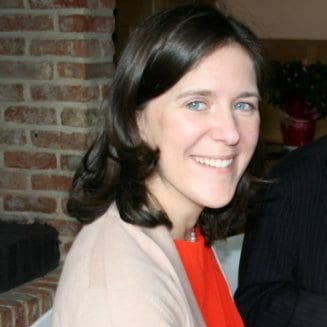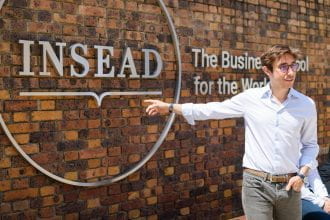 Listening attentively to presentations on INNOVATION, the subject of the Family Enterprise Day on 18 June 2016, Hélène Bostoen, MBA’05J, wondered how she could apply these learnings to her family’s land development company in Belgium. Her plan was to create a board by July 2016, consisting of two external directors and three internal directors. Said Hélène, “the new board will ensure continuous innovation and dynamism within our family business.”
Listening attentively to presentations on INNOVATION, the subject of the Family Enterprise Day on 18 June 2016, Hélène Bostoen, MBA’05J, wondered how she could apply these learnings to her family’s land development company in Belgium. Her plan was to create a board by July 2016, consisting of two external directors and three internal directors. Said Hélène, “the new board will ensure continuous innovation and dynamism within our family business.”
More than 60 participants, including current INSEAD MBA students and invited guests, attended the all-day seminar sponsored by the INSEAD Wendel International Centre for Family Enterprise. Professor Morten Bennedsen, the academic director of the Wendel Centre, opened the conference by advising the 60 participants to institutionalise innovation in their family firms. He cited four drivers of innovation: the family assets embedded in family firms (see table below), the continued survival of family firms, the role of next-generation family members and the positive dynamic arising from conflicts among family members.[1]

Family Assets and Innovation[2]
Family Assets Provide Family Firms with Excellent Innovation Capabilities
Family name, legacy, and values often confer an advantage for family firms in the hiring process and in retaining talent. Highly sought after prospective candidates, for example, often prefer to apply for jobs in firms with a family-based innovation legacy. Such candidates are quickly transformed into highly productive, innovative and creative employees. Moreover, existing staff are motivated by the same family assets as well. Two companies can be cited where this phenomenon occurred:
- Heraeus: A German metal company that attracts top engineering and natural science graduates;
- Lego: The world’s largest toy company that attracts some of the best creative product developers.
Loyalty in Family Firms is a Game Changer
 One of the most important drivers of innovation in family firms is loyalty, a dimension which is not present in most non-family firms, the professor said. Family business members—and following their example, company employees—are often driven to innovation by an intense loyalty to their firms.
One of the most important drivers of innovation in family firms is loyalty, a dimension which is not present in most non-family firms, the professor said. Family business members—and following their example, company employees—are often driven to innovation by an intense loyalty to their firms.
The loyalty factor is a game changer. Instead of giving up the ship in the face of tough times, family business leaders are more likely to find innovative solutions to overcome shakeups in their markets or sectors. Rather than avoid problems or exit their businesses, family leaders are more likely to focus their attention on removing roadblocks or overcoming them.
One example of a family-owned company that exited a business is Van Eeghen & Co B.V., which started life as a Dutch trading company shipping wool, wine, salt and sugar across the seven seas when it was founded in 1662. Recently, Van Eeghen had to exit a niche market because it turned into a commodity-like business where margins were squeezed dry. In response to the shakeup, Van Eeghen started looking for new products and markets with niche characteristics. Family members, loyal to their business, discovered a new opportunity: the distribution of vitamins and minerals to the infant formula industries and the sports and nutritional supplements business. Under the leadership of a next generation family member, the holding company launched a wholly owned subsidiary called Van Eeghen Functional Ingredients B.V.
However loyalty can also turn into a liability. Lego, the successful firm owned by the second-generation Kristiansen family in Denmark, provides a telling lesson. Out of loyalty to its workers and the community in the small town of Billund where it was founded, Lego tried to hold onto its employees and production facilities for longer than it should have. Most of its competitors had already started outsourcing production to countries where labour costs were much lower. Eventually Lego was finally forced to cut back its workforce and close down facilities in its hometown. Fortunately, Lego survived the crisis and continues to operate a Legoland theme park in Billund.
Measuring Readiness to Innovation
Daniel T. Holt, Associate Professor of Management, Mississippi State University, gave a spirited lecture on innovation and a firm’s readiness to innovate. Professor Holt suggested that structural factors should be considered in assessing a firm’s readiness for innovation. He cited such structural factors as ownership control, family commitment and alignment of existing knowledge, skills and abilities. In addition, Professor Holt said psychological factors are also important as they reflect the extent to which members of the family and firm are cognitively and emotionally inclined to accept, embrace, and adopt an innovation. Accompanying him on the speakers platform was Joshua J. Daspit, Assistant Professor of Management at Mississippi State University.
After listening to the presentations on innovation, Hélène Bostoen was confident that she could apply these learnings. She was reminded of the spirit of innovation and entrepreneurship in her own extended family. For the past three generations, her family has encouraged members to create new businesses. She cited 50 direct cousins among whom a vast majority are entrepreneurs and several very successful.
SAVE THE DATE: The next Family Enterprise Day will take place at the INSEAD Europe campus on 24 September 2016. This event will be jointly sponsored by the INSEAD Wendel International Centre for Family Enterprise and the Henokiens, a French-based association of 47 family-owned firms that are more than 200 years old.
Morten Bennedsen is The André and Rosalie Hoffmann Chaired Professor of Family Enterprise and Academic Director of the Wendel International Centre for Family Enterprise; Brian Henry, PhD, is a Research Fellow, both at INSEAD.
[1] Family Assets and Liabilities in the Innovation Process, by Morten Bennedsen and Nicolai Foss, California Management Review, Vol. 58, No. 1, pp. 65–81, 2015
[2] Ibid, page 69


